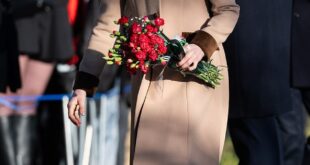Dancers Stephan Azulay, front left, and Tymin Keown, front right, rehearse for the Royal Winnipeg Ballet’s T’əl: The Wild Man of the Woods, which debuts April 25.
Silhouetted against beams of fluorescent light shining from the ceiling of a vast studio, more than two dozen dancers from the Royal Winnipeg Ballet listened closely to choreographer-in-residence Cameron Fraser-Monroe.
In the centre of the room, ballerina Emilie Lewis spread her arms out like wings. She took flight to the sound of her instructor’s voice, held aloft by the encircled ensemble lifting her from below.
“Brilliant. Keep paying attention to each other,” said Mr. Fraser-Monroe, nodding with satisfaction.
Cameron Fraser-Monroe is a member of the Tla’amin First Nation in B.C., whose stories inspired T’əl.
That evening, a week before the RWB’s last production of the season, as sonorous strings filled the air, the 26-member troupe was acutely aware: They were about to make history. For the first time since it was founded in 1939, North America’s longest continuously operating ballet company is collaborating with Indigenous artists from across Canada and the United States to present a performance in a First Nations language.
T’əl: The Wild Man of the Woods, an entirely new ballet, will premiere at Winnipeg’s Centennial Concert Hall on Thursday for a four-show run. But there are already talks about the international touring company taking it on the road.
Contrary to most ballets, which typically rely solely on movement as a storytelling device, the hour-long piece will be narrated in Ayajuthem and English by Elder Elsie Paul, a knowledge keeper of the Tla’amin First Nation on British Columbia’s upper Sunshine Coast. A residential school survivor, Ms. Paul is one of the few remaining people fluent in Ayajuthem, a language native to her nation.
Indigenous artists have been involved at all levels of T’əl’s production, from costuming and music to the narration in the Ayajuthem language.
Two-spirit composer and cellist Cris Derksen, who comes from a line of chiefs from the North Tall Cree Reserve in Alberta on her father’s side and has Mennonite heritage on her mother’s side, will join the Winnipeg Symphony Orchestra with a live score from the pit of the concert hall.
Navajo designer Asa Benally, a New York-based alumnus of Yale University, is leading the costume work.
T’əl – pronounced “tall” and spelled in Ayajuthem with an upside-down and backward “e” – is inspired by the various legends that Mr. Fraser-Monroe, the creative force behind the RWB’s performance, grew up hearing as a member of Tla’amin, years before he found his calling in ballet.
“It feels like all my life’s work has led up to this point,” he told The Globe and Mail.
A decade ago, Mr. Fraser-Monroe was a teenaged newbie in Winnipeg just trying to get through RWB’s rigorous program.
In Grade 10, he was visiting the Prairie city on a trip with his dad when he was recommended by his West Coast dance teacher to try out for the prestigious ballet school. At the audition, he was offered a scholarship on the spot. He soon left his British Columbia high school for the housing facility on campus, joining ambitious peers recruited by the RWB from around the world.
After getting commissions by many national ballet companies as a choreographer, and performing globally as a dancer, the 25-year-old now holds the company’s coveted choreographer-in-residence position that allowed him to create T’əl.
“We’ve all been talking about how I wanted to make this happen for over two years,” Mr. Fraser-Monroe said, sitting in the RWB’s lobby. “This is the kind of story that’s for everyone, but especially pays honour to something we never get to see or hear among the Eurocentric fairy tales we’re used to at the ballet.”
The piece follows the tale of a wild man who kidnaps children from a village after dark and then disappears – until one day a young woman dares to be brave as she ventures to save her sister.
“It’s simple like most ballet stories, but there’s so many layers,” said Mr. Fraser-Monroe, who has been working on the piece since October last year. He went back to Tla’amin to learn everything about the legend of T’əl straight from the source: his elders.
Talking with elders helped Mr. Fraser-Monroe, 25, to get to the heart of the story he wanted to tell.
He frequently consults by phone with his dad and auntie to learn about traditional teachings. In order to fully understand this story, however, he had to sit down with Ms. Paul, who then shared with him its significance.
“Because I’m bringing forward a story that wasn’t told to everyone as they’re falling asleep at night, and for which there is no official text, I have to often fulfill the role not only of creation, but also of education,” he said.
“In my past works, that’s meant me being the one that is speaking. But I thought I can’t do nearly as good a job of passing down this story as the person who has spent her entire life maintaining it through hardship.”
The English narration is so the tale can be understood by everyone, while the words in Ayajuthem are an homage to the few who know where it comes from.
Stories such as this, Mr. Fraser-Monroe said, barely made it through Canada’s assimilation policies and residential schools. They were also made illegal during the potlatch ban, which saw the Canadian government forbid Indigenous peoples to pass along their customs to their descendants from at least 1885 to 1951.
“That’s what makes this so special. Now, our piece will give this story its legs,” Mr. Fraser-Monroe said. “It can be told over and over again.”
None of the dancers in T’əl are Indigenous, but Mr. Fraser-Monroe hopes the production will inspire other Indigenous artists to consider ballet.
The dancers Mr. Fraser-Monroe is working with for T’əl are not new to him. He has performed with some of them and choreographed the whole troupe on at least two other occasions, albeit never on such a large scale.
But he is cognizant of the fact that none of the company’s dancers are Inuit, Métis or from a First Nation.
That’s something he is hoping the new production can change, inspiring other Indigenous artists to embrace the potential of ballet. In the meantime, he is making the conscious casting choice to give featured roles to every dancer of colour in the company.
“I’m proud for this piece to be a first in many respects. I just don’t want it to stop there, with me or anyone else,” he said. “Because when I walked into this space, I didn’t see myself fitting in. I just didn’t see myself represented.”
André Lewis, RWB’s artistic director, who will celebrate 50 years with the company in 2025, called the new work a “historic milestone.” He said it epitomizes the power of storytelling through dance and showcases a commitment to cultural diversity.
‘It feels like all my life’s work has led up to this point,’ Mr. Fraser-Monroe says.
On the night of the premiere, Mr. Fraser-Monroe’s two moms are coming from their home in Vernon, B.C. His brother, who is on a volleyball scholarship in New Brunswick, is driving from Saint John.
His dad, who is from Tla’amin, is also flying in. But he’s not sure whether his dad’s husband can make it. “I think he just broke his ankle,” the dance director said with a chuckle.
Mr. Fraser-Monroe is hoping to watch his ballet from somewhere in the furthermost corners of the concert hall.
“I’ve spent so much of my time with the work right in my face,” he said. “That night, I just get to enjoy it with everyone else.”
Source link



